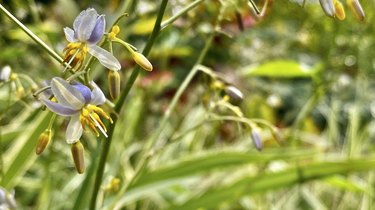
The green or variegated leaves of the flax lily (Dianella tasmanica) cover the soil in part-shade gardens across U.S. Department of Agriculture plant hardiness zones 8 through 11 depending on the cultivar. While they are easy-care rhizomatous perennials, pruning variegated flax lily and the other cultivars may be necessary when the white and green leaves have reverted to all green, or too many dead leaves linger on the plant.
About Flax Lilies
Video of the Day
The flax lily, also known as Tasman flax lily or blue flax lily, is one of the approximately 25 Dianella species that thrive from tropical Africa to Polynesia. Native to Australia, this 18- to 24-inch-tall grasslike perennial spreads to 3 feet wide in clumps. It prefers part or dappled shade and tolerates drought and salty soils, making it ideal for dry landscapes under trees.
Video of the Day
The spires of tiny blue to violet flowers appear on stalks rising above the foliage in late winter, spring and early summer, resulting in blue berries in fall. Though normally evergreen, in the colder areas of USDA zones 8 and 9, the foliage may be killed by freezing temperatures. If planted in a protected area and well mulched, the plants will grow back from the rhizomes.
Among the green-leafed flax lily cultivars are 'Little Becca' at 18 inches tall; 'Baby Bliss,' which grows only 12 inches tall and features pale-violet flowers and purple berries; and 'Little Rev,' which matures into a 4-foot-tall and 2-foot-wide clump. Often planted in landscapes for visual interest, 'Variegata' has green leaves outlined with white, while 'Yellow Stripe' features alternating light-green and dark-green, white and yellow stripes. 'Variegata' may grow 3 1/2 feet tall, and 'Yellow Stripe' grows up to 2 feet tall.
Planting Flax Lilies
Divide and transplant existing plants, rhizomes or potted flax lilies in spring. Select a well-drained, dappled or part-shade location and dig the garden bed, removing rocks, twigs, weeds and other plant matter. Dig in 2 to 3 inches of compost and well-decomposed manure to a depth of 8 to 12 inches. Prepare the planting holes at least 3 feet apart to allow for growth and fill them with water to ensure a moist environment to encourage root growth.
Plant flax lilies at the same depth that they were in the growers' pots or the garden. If planting rhizomes, plant them 1 to 2 inches deep and horizontally with the roots down and the green sprouts, or "eyes," up. Cover the rhizomes with the excavated soil. Tamp lightly and water thoroughly.
If you are planting in flowerpots, use a standard potting mix or combine equal parts compost, peat moss or coconut coir, coarse sand and perlite or vermiculite. Nestle the plant or rhizome in the center of the pot and then fill in the edges with small trailing plants or vines. Place it in a part-shade location and water until the water drains from the bottom of the pot.
Caring for Flax Lilies
Water regularly while the flax lilies become established in the landscape, generally applying 1 to 2 inches of water weekly. After the first few months when the plants are actively growing, they can tolerate drier conditions. Add a layer of mulch over the bare soil to help reduce water evaporation from the soil and to discourage weed seed germination.
When growing flax lilies in containers, keep a close eye on the moisture level. Planting mixes dry out quickly in hot weather. Water when the soil is dry to a depth of 1 to 2 inches.
Fertilize your flax lilies in spring before new growth appears. Apply a balanced, slow-release fertilizer formulated for acid-loving plants, like azaleas. Alternatively, add a shovelful or two of compost around the plants but don't cover the crowns. Always water after fertilizing.
Pruning Variegated Flax Lily
If your flax lilies have an excessive number of dead leaves or the variegated leaves have turned solid green, it's time to trim. Put on gloves and safety glasses and sterilize your cutting tools by dipping the blades in rubbing alcohol or Lysol.
Trim dead leaves from the plants. If the plants suffered winter damage or the leaves have changed colors, cut the foliage all the way back to the crown in late winter to encourage new growth. The tips of the leaves tend to turn brown; you can trim or ignore this as a natural part of the plants.
While sources vary on the reputed toxicity of the rhizomes, plants and berries, any plant matter can cause gastric distress in humans, cats and dogs. Play it safe and keep them out of the reach of children and pets.